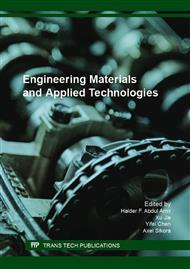p.3
p.9
p.14
p.20
p.25
p.30
p.37
p.42
p.49
Ultrasonic Assisted Synthesis of Reduced Graphene Oxide in Glucose Solution
Abstract:
A new carbon material viz. graphene has been attracted an increasing research interest owing to its unique electrical and mechanical properties that is useful for the various device applications. The synthesis of graphene from graphene oxide usually involves harmful chemical reducing agents that are toxic and undesirable to human and the environment. By avoiding the use of toxic and environmentally harmful reductants, we report a green approach to effectively reduce graphene oxide to graphene in glucose solution at room temperature. Graphite oxide was synthesized from graphite powder using modified Hummers’ method. Graphite oxide then further exfoliated to graphene oxide by using ultrasonic irradiation. The mild reduction of graphene oxide is carried out by mixing graphene oxide solution with glucose. The reduction time is varied with 15, 30, 45 and 60 minutes. TEM images provide clear evidence for the formation of few layer graphene. Characterization of theresulting glucose reduced graphene oxide by FTIR indicates the partial removal of oxygen-containing functional groups from the surface of graphene oxide and formation of graphene with defects.
Info:
Periodical:
Pages:
25-29
Citation:
Online since:
September 2016
Keywords:
Price:
Сopyright:
© 2016 Trans Tech Publications Ltd. All Rights Reserved
Share:
Citation:


